Understand Jewellery Design and Manufacturing Process: A Detailed Guide for Jewellery Enthusiasts
Manufacturing jewellery is a process that takes time and much skill, like any other art form. Each jewellery piece must be conceptualised by the designer keeping in mind all the possible techniques and drawbacks of the manufacturing process and then must be transformed into beautiful pieces that we can sell and wear. Back in the day jewellery was made entirely by hand, metals were all moulded to shape and the setting of gemstones was done patiently by hand. These days with the advancements in technology, bench jewellers and artisans are equipped with multiple machines and technologies to help them craft each one of their masterpieces with ease and speed.
DESIGNING
Jewellery must first be designed before any manufacturing can be done, each jewellery piece must be meticulously thought through with much trial and error. Designing the jewellery at KuberBox follows a set of steps before they can be manufactured into our masterpieces. All our jewellery is both wearable and durable, two important factors that all jewellery must match up to. Wearable, so jewellery is comfortable, light, and beautiful and durable to withstand common wear and tear. As with everything, even jewellery starts off with an idea. A jewellery piece could get its inspiration from a window at the Palace of Mirrors in Jaipur or a print that was present on a child’s water bottle. Anything could give our designers the inspiration they need. These ideas are then translated into a design that can be used in jewellery and looks graceful complementing its use. As a KPP you must be able to sell a design to the right person. Speaking about a design versatile wearability is essential as a lot of jewellery can be taken from the day to the night and with different outfits.
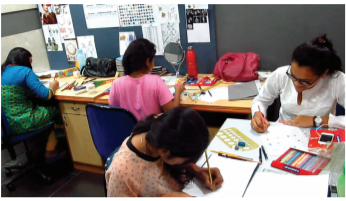
Our Chivalric Ruby pendant with its delicate design is not too big and yet very functional at the same time. The excellent workmanship can be seen with its perfectly set diamonds and the balance the ruby gives to the right of the design. The design has a flexible and fluid design making it fit comfortably on your client’s neck, emphasising her beautiful neckline. This is how you need to explain the design to your customers. You have to understand the customer’s needs and then give her something that fulfils her needs in the best possible way.
COMPUTER AIDED DESIGN
This idea once rendered into a sketch on paper goes through a set of checks with our head designers. Once approved after an in-depth analysis this 2D sketch is then transformed with the help of Computer Aided Design techniques into a 3-dimensional image. The CAD software enables the designers to convert their ideas into designs and get an insight into what the jewellery piece will look like. This 3D image gives a complete and thorough view of each part of the final jewellery piece. Once the creative team approves the designs based on design aesthetics, it then is moved to the production manager’s arena. He then prototypes the jewellery and decides if that particular design can be made defect-free. It is important that the designs are practical for manufacturing. If the production team gives a green signal, the design is then made available to all our customers. An RPT (Rapid ProtoType) is made during the prototyping stage by the production team, which is generally used as a master sample. RPTs are made using the same technology as a 3D printer and can be made within minutes, thereby reducing the time scale of the design and in turn the manufacturing process. This RPT is used to make a liquid resin dye, which can then be used to manufacture the jewellery.
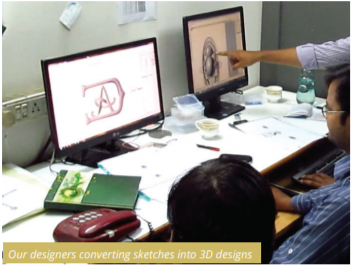
The designing process is followed by the manufacturing process, which begins with:
LOST WAX CASTING/CASTING METHOD
Today a lot of the jewellery being sold commercially and on a large scale is being produced through this method. It gives both economies of scale when it comes to mass production along with the flexibility in production as both complex and simple designs can be easily replicated. A rubber mould is first made to replicate the perfect jewellery piece. The artisan has to carve this rubber for the jewellery piece to come out exactly right. Once the mould has been commissioned, the liquid hot wax is injected into the rubber mould. This wax once cooled and hardened leaves behind a jewellery piece made entirely of wax. A single rubber mould can be used to replicate numerous pieces. Each wax model is placed with other designs on a cylindrical structure, which resembles a tree. Then placed in an investment (a device used to melt the wax) the wax is melted away and replaced by Plaster of Paris. The liquid metal is then poured into the cast and left to cool. Once cooled the plaster is broken open leaving behind jewellery pieces in the chosen metal.
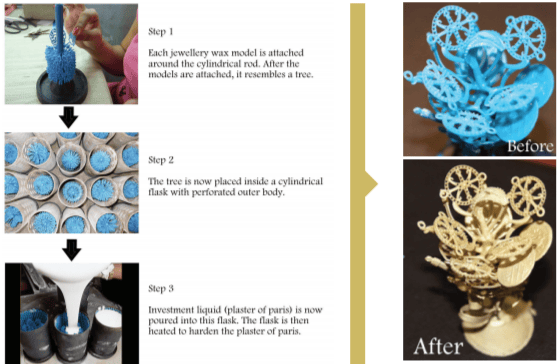
This is known as the casting process where the jewellery is brushed and buffed to remove any rough edges and come alive. It is then passed to the setters (the person who ‘sets’ the stones on jewellery) to add in the gems thereby giving your jewellery piece the lift it needs. We cover in depth the setting process over the next few chapters. Knowing the way in which jewellery is designed and manufactured gives you an upper hand when it comes to technical details in terms of what your customer is looking for, as you will be able to meet their needs. Your knowledge of the design and the manufacturing process will help push a sale using the benefits of each feature present in the jewellery. The process of casting is being used increasingly to make shanks and heads separate from each other, as they can then be assembled together to give one final piece of jewellery giving strength and durability to the design.
HANDCRAFTED JEWELLERY
Hand fabrication of jewellery, which used to be the sole method of producing the magnificent jewellery of the Maharaja’s of our country and the world is done even to this date. “Karigars” as they are known in India make an entire piece of jewellery by hand, from moulding the gold all the way to the jewellery’s final finishing. They used hand tools to fashion and create each stroke on the metal giving the piece so much more character and is still done to this day by select workshops across the world.
When jewels are manufactured by hand, it usually goes through the following process:
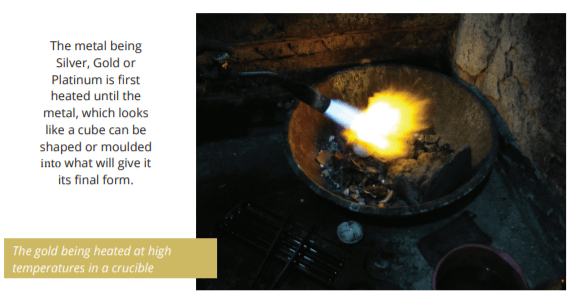
This then moves on to a process called “Patti”. It is where a heavy wheel presses the metal under pressure giving it some shape. Patti stands for both the process as well as the outcome of this process. The metal block is rolled under heavy wheels to make sheets or wires that make the various forms needed to make an entire jewellery piece. During this process, the metal is heated in constant intervals to increase its malleability.
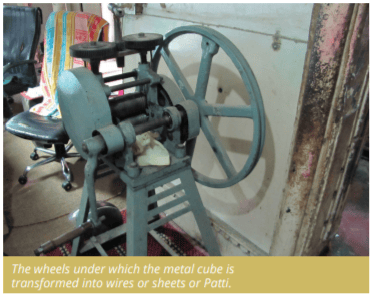
Once the required thickness has been reached, it is moved to the karigars table to make a “supti” or base. This supti is generally the collets, rings, links, shanks, and bands etc., which will finally hold the gemstone and be part of the design.
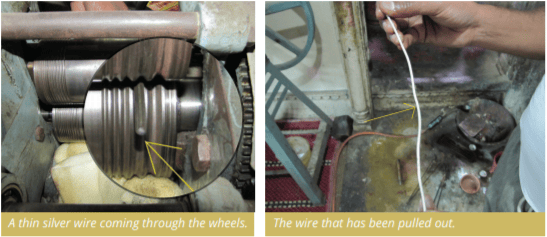
Each of these as individual pieces is then soldered together to form the final shape. In some designs when jewellery is being soldered together, they are often placed in a black waxy material called “moum” that helps maintain the shape so as to obtain a perfectly symmetrical piece. Once in the moum, plaster of Paris is added on top. The soldering is then done worry free in perfect symmetry.
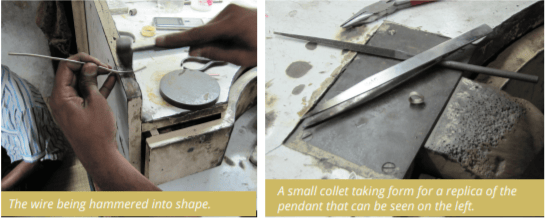
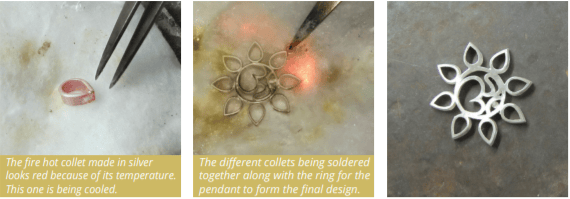
DORA POLISH
Just like how threading is used to remove unwanted facial hair, In Dora Polish a Dora (thread) is used to polish off rough metals & edges at difficult corners where the usual tools cannot be used. Once taken out of the black wax, a “do” polish is done. This polish is done for the small holes or filigree work, which cannot be accessed by the big polishing wheel. The jewellery piece is also put in the ultrasonic machine so as to remove any wax that gets stuck in places that cannot be seen and removed by the karigar.
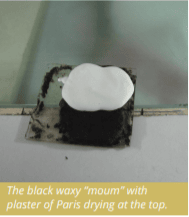
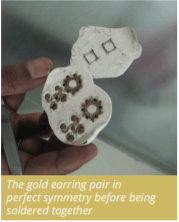
ULTRASONIC CLEANING
Ultrasonic cleaning is a cleaning process that uses the ultrasound waves to clean dirt, grime and manufacturing residue from the jewellery. These waves are an extremely high frequency which results in something called Cavitation – The sudden creation and collapse of low-pressure bubbles in the liquid. The ultrasound can be used with just water, but the use of a solvent appropriate for the item to be cleaned and the type of soiling present enhances the effect. Hand-made jewellery reflects the skill of the “karigar” and gives them the freedom to make alterations based on the outcome of the design or the more difficult to deal with alterations like changes in size etc. Hand fabricated jewellery also commands a higher price because each piece takes much skill and will always have small differences between each other.
DIE STRIKING
Die Striking is one method of making jewellery in which a die made of steel strikes a precious metal sheet, giving it shape. Made of two essential parts the punch and the mould it is perfect for lightweight jewellery for everyday use. The jewellery made through this process is also much more durable because it compresses the metal making it stronger. This method is good for prongs, as they need to be durable. A sheet of the metal is used and the die is then punched out. They can be charms or findings of the jewellery piece that need to be soldered together. These pieces of jewellery also require less finishing as they tend to take on the finish of the die itself. Jewellery made with this process is very wearable.
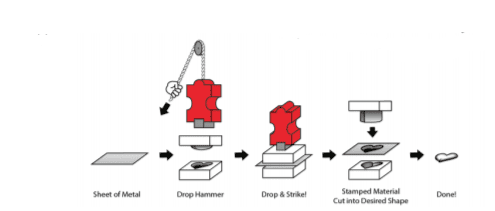
ELECTROFORMING AND ELECTROPLATING
Electroforming is another technique used in the manufacturing of jewellery. In this process, the chosen base made from wax is used and is painted with an electrically charged layer. When submerged in a noble metal liquid, it attracts particles leaving a layer on the wax form. This can be continued until the desired thickness is achieved. The wax is then melted out through a small hole in the jewellery piece unseen by the eye. Although extremely light weight, the electroforming process isn’t a good option for durable jewellery. It’s perfect for jewellery that does not undergo a lot of wear and tear like rings. It is ideal for pendants and earrings as they are light in weight. This jewellery is also much more affordable. Despite the theoretical advantages of an electroformed jewellery, they are not common and aren’t used as much. Electroplating is another process where metals are made to look like fine metals by coating them with thin layers of gold, silver or platinum. This process is just like electroforming although the fine metal is deposited on another metal, which makes up the jewellery piece. The positive ions get attracted to the negative ions leaving behind a layer jewellery piece. This is essentially the same process used to Rhodium plate a jewellery piece.
You must have heard about gold plated jewellery. This is nothing but a thin coating of gold on top of the existing metal jewellery. For example, silver jewellery articles are generally plated with a thin layer of gold to increase its perceived value and also to save the silver jewellery from getting tarnished.
Jewellery Design and Manufacturing Process FAQ:
- What is the process of making jewellery?
The designing process is followed by the manufacturing process, which begins with: Lost wax casting/casting method. This is known as the casting process where the jewellery is brushed and buffed to remove any rough edges and come alive. It is then passed to the setters (the person who ‘sets’ the stones on jewellery) to add in the gems thereby giving your jewellery piece the lift it needs.
2. How often should you clean your jewelry?
Every two weeks to remove daily dirt, to maintain the look of your jewellery, and keep germs at bay, you need to gently clean your regular jewellery every two weeks.
Understand Jewellery Design and Manufacturing Process: A Detailed Guide for Jewellery Enthusiasts by Team KuberBox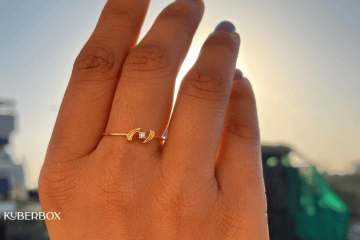

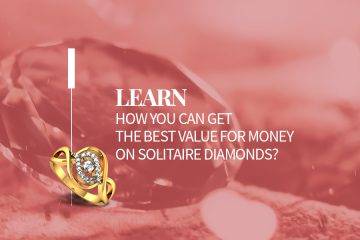
0 Comments